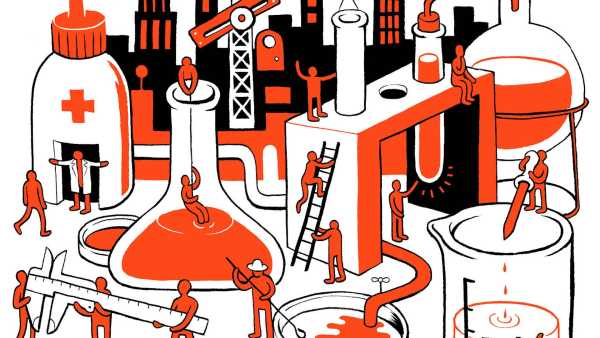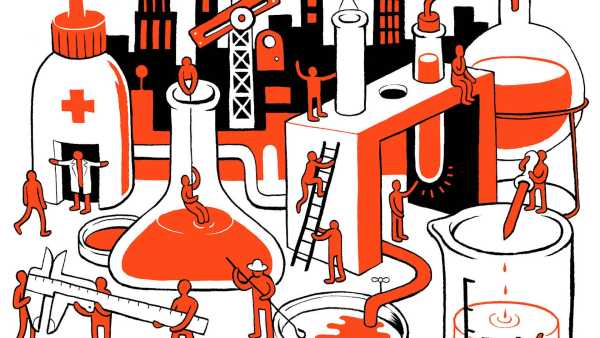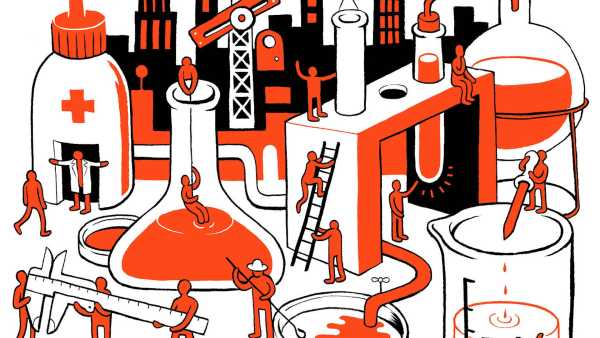
During the COVID-19 pandemic, people began to criticize 4G and 5G due to the false belief that radiofrequency radiation is the cause of the disease. (Image credit: Busà Photography/Getty Images)
When the COVID-19 pandemic broke out, a bizarre conspiracy theory spread across social media around the world: the disease was caused by radiofrequency radiation from 5G cell towers. These wild theories spread across social media. Belief in this conspiracy was so strong that media outlets reported more than 100 cases of arson and vandalism of 5G (and 4G) infrastructure, as well as numerous cases of abusive or threatening behavior toward telecom workers.
Why do such strange events happen? In our recent review article, published May 19 in the journal Frontiers in Communication, we showed that conspiracy theories and other common false beliefs arise from complex interactions involving people’s cognitive limitations, social influence in groups, and the global spread of ideas on social networks.
This fatal combination of processes at different scales – individual, group and global – has led to the emergence of the online problems we see today. Their complexity makes combating the resulting social trends incredibly difficult.
You may like
-

Scientific objectivity is a myth. Here's why
-

Only 64% of Americans Accept the Idea of Evolution—Here's One Reason Why
-

Climate action faces a new threat: pessimists who believe it is too late to act
Preparedness for poor thinking and strange behavior in a group
The root of our thinking problem is our evolution. Our ability to handle complex information is limited, so our brains take shortcuts, such as confirmation bias — the tendency to notice things that fit our pre-existing beliefs and ignore things that don’t. For example, we quickly forget that we’re in a fast line, but we remember how annoying a slow line is, and we ask ourselves, “Why am I always in a slow line?”
Another sign of our inability to cope with complexity is the tendency to see malice in complex, inexplicable events. This tendency has sown the seeds of many injustices, from witch hunts to conspiracy theories. The reality is that unexpected events and behavior often emerge from interactions without any conscious intentions.
When people gather in groups, strange behavior often occurs. False beliefs, like epidemics, can spread from person to person. Have you ever been afraid to ask a question in class? You think everyone else understands you and you don’t want to look stupid, but sometimes no one understands you. This problem, known as pluralistic ignorance, is at the root of many social problems. For example, people who are usually helpful often become passive observers in the presence of others, unable to help someone who is hurt.
A similar problem is groupthink: everyone stops speaking up to protect their group's reputation, even if they disagree, and blindly follows the leader. Groupthink has been the cause of many famous disasters, including the Challenger space shuttle crash.
Another problem with potentially catastrophic consequences is polarization, where a group becomes divided into two camps with opposing, irreconcilable viewpoints that become increasingly divided over time.
It is well known that pluralistic ignorance, groupthink and polarization are “emergent” phenomena that arise naturally when conditions are right. This self-organizing behavior of groups is often not recognized and is often attributed to other causes. This is why governments, the media and the public are often taken by surprise when groups suddenly appear promoting strange agendas.
You may like
-

Scientific objectivity is a myth. Here's why
-

Only 64% of Americans Accept the Idea of Evolution—Here's One Reason Why
-

Climate action faces a new threat: pessimists who believe it is too late to act
The above forms of group behavior arise spontaneously when individual cognitive deficits interact to produce dysfunctional group behavior. They are based on a deep social desire for safety in a group. This fuels errors in our thinking and motivates people to take the “safe” route and follow the crowd.
Rapid spread of extremist views
The problem today is that what was once just a few whispers can now ignite chaos. Imagine life in a traditional village hundreds of years ago. It’s a small world. Ideas are passed on by word of mouth from person to person. They spread very slowly as visitors move from village to village. Even today, we still live in many “villages” – family, neighbors, coworkers, friends – and ideas spread as we move between groups.
The advent of mass media has given some people far greater reach than ever before. It has facilitated propaganda while amplifying extreme views. Online, groups of people are connected regardless of geographic distance, so individual views can be reinforced by large groups of supporters.
Communities of like-minded people emerge on social media. This includes the rapid spread of extremist views and conspiracy theories. The interaction of people with extreme views on social media allows very large groups to share malicious views. Bizarre actions, such as the 5G sabotage mentioned above, can manifest themselves, often very quickly.
Truth cannot compete with lies
Why do misleading messages spread so well? They can be designed to seduce audiences by exploiting known cognitive biases. This technique is widely used in politically polarized media, social media, and biased fact-checking. It exploits confirmation bias and motivated cognition. Truthful messages simply cannot compete with personalized fakes.
Similar stories
— RFK Jr. wants to reform the country's “vaccine court.” Here's what's standing in his way.
— Research has shown that most methods of debunking conspiracy theories don't work. Here's what does.
— Should people get their health information from YouTube? Retired surgeon and content creator Liz O'Riordan on 'cutting through the absurd'
Another well-known cause is the spread of information through social media, especially when connected to very fast and ubiquitous digital networks. Research has shown that false messages tend to spread in patterns similar to those used by epidemiologists in medicine. “Influencers” on social media often become “super-spreaders” of false and misleading content.
The above behavior suggests that authorities can suppress the spread of false messages by treating them as epidemics. These are typically addressed through three steps: suppressing the source, limiting the spread, and increasing immunity in the exposed population. If the pathogen is digital, this means blocking or deplatforming the creators and distributors of malicious messages, filtering malicious content on media platforms, and training audiences to be resilient to malicious content.
This is easier said than done.
There is no way out
Creators and distributors will use free speech laws and/or switch platforms and media types. Meanwhile, audiences may continue to believe malicious nonsense and are prone to forget what they were taught over time. Unfortunately, there are a huge variety of ways to spread malicious messages.
Today the world faces the prospect of a constant “arms race” in tactics and technology between those who peddle propaganda and nonsense and those who try to tell the truth, with audiences often not sufficiently informed to distinguish between fiction and fact.
Communities that choose not to participate in this “arms race” will be inundated with lies and will suffer from growing social discord as consensus on any issue that concerns the community is disrupted to the point of paralysis. Communities that choose to resist the attackers will have to spend time and resources participating in the “arms race” and trying to prevent or control undesirable consequences.
There is no simple panacea: hoping to find one is wishful thinking.
“Opinion on Living Science” gives you insight into the most important science issues affecting you and the world around you today, written by experts and leading scientists in their fields.

Carlo Kopp
Carlo Kopp is a Research Associate in the Cyber Security Group in the Faculty of Information Technology at Monash University in Melbourne, Australia. He holds a PhD and MSc in Computer Science from Monash University. His previous experience includes positions in the computer industry as a hardware and software code developer, positions at think tanks in defense analysis and strategic studies, and academic research in a variety of fields, including over 500 publications. He is best known as an early researcher in information warfare, for his work on infrastructure vulnerability to electromagnetic threats and his involvement in the development of the Borden-Kopp information-theoretic deception model.
You must verify your public display name before commenting.
Please log out and log back in. You will then be prompted to enter a display name.
Exit Read more

Scientific objectivity is a myth. Here's why

Only 64% of Americans Accept the Idea of Evolution—Here's One Reason Why

Climate action faces a new threat: pessimists who believe it is too late to act

The rise of artificial intelligence – how does it affect the way we use the internet?

“We have effectively destroyed our entire capacity to respond to a pandemic,” says leading epidemiologist Michael Osterholm.

The study found that people who perceive brutal politics in society value antagonistic leaders.
Latest news on human behavior

Live Science Crossword #10: Tallest Volcano on Earth – 10 Points Down

Live Science Crossword #9: Hooded King Snake – 14 Horizontal

Scientific objectivity is a myth. Here's why

Live Science Crossword #8: Coldest Possible Temperature in the Universe — 3 minuses

Live Science Crossword #7: The NASA Mission That Redirected an Asteroid — 8 Horizontal

Live Science Crossword #6: Planet with a 'Great Red Spot' – 6 not found
Latest opinions

'When people gather in groups, strange behavior often emerges': How the rise of social media has led to the emergence of dysfunctional thinking

'Your concerns are well founded': How human activity has increased the risk of tick-borne diseases like Lyme disease

How the surface you exercise on can increase your risk of cramping

'Serious Negative and Unintended Consequences': Polar Geoengineering Is Not the Answer to Climate Change

JWST Hints TRAPPIST-1e May Have Atmosphere

Robert Kennedy Jr. Wants to Reform the Nation's 'Vaccine Court.' Here's What's Stopping Him
LATEST ARTICLES

1History of Science: The Tragic Death of Gene Therapy That Halted the Field for a Decade – September 17, 1999
Live Science is part of Future US Inc., an international media group and leading digital publisher. Visit our corporate website.
- About Us
- Contact Future experts
- Terms and Conditions
- Privacy Policy
- Cookie Policy
- Accessibility Statement
- Advertise with us
- Web Notifications
- Career
- Editorial Standards
- How to present history to us
© Future US, Inc. Full 7th Floor, 130 West 42nd Street, New York, NY 10036.
var dfp_config = { “site_platform”: “vanilla”, “keywords”: “type_opinion,serversidehawk,videoarticle,van-enable-adviser-
Sourse: www.livescience.com





